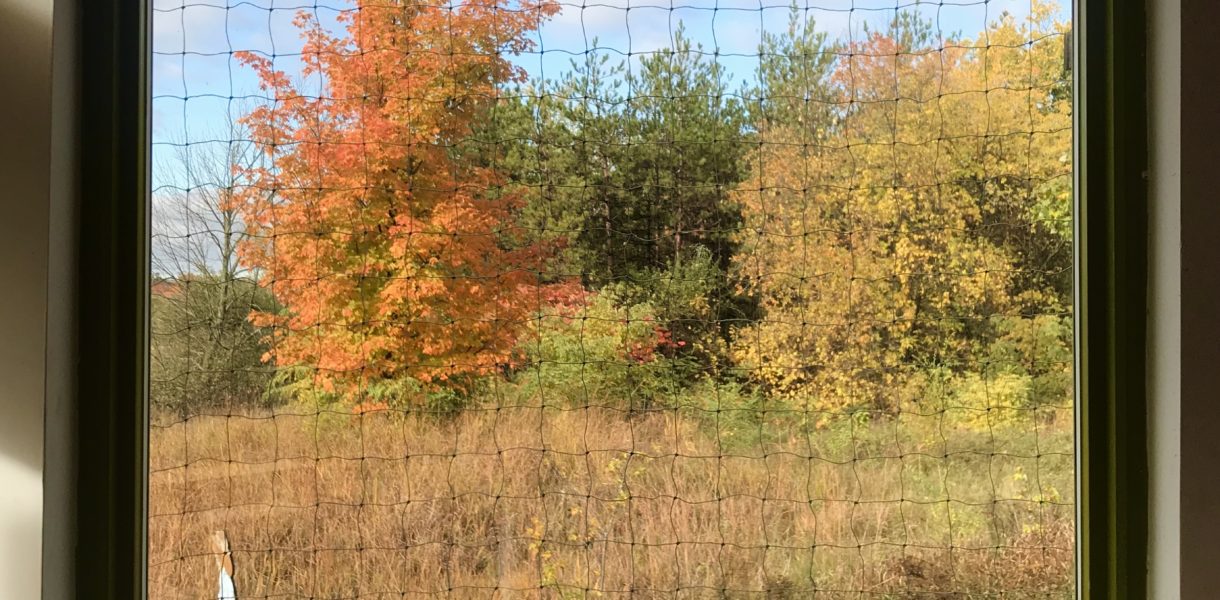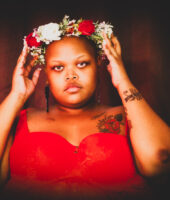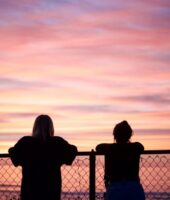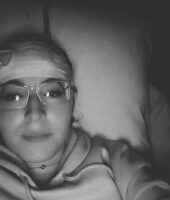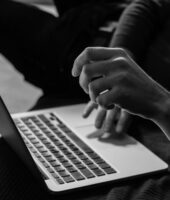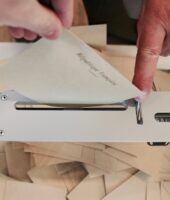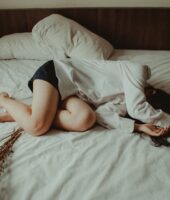Nearing the last breath of fall, the heat let us play pretend while surrounding trees decided when to sew their foliage into the ground’s seasonal blanket. I could tell they hadn’t made up their minds yet since most of the leaves clung to branches and teetered in the air, but slowly some of them were turning cinnamon brown, coating the grassy floor and crisping under our toes.
The landscape had submitted itself to ecstasy, each colour its most chromatic, the world so big and so small I could hold it in the palm of my hand. My greatest worries were that I couldn’t drink the sunset, and that while standing in a pumpkin patch, I thought that my friend, costumed in a bright orange cardigan, had turned into a pumpkin. Untethered from man-made instruments, light moved gently across the sky and over the garden to suggest that time still existed. When the sun finished smudging the horizon into melted crayons, we retreated into the safety of the cabin, cocooned by wooden walls, trying to make sense of their detachment from the trees outside.
All three of us knew something had shifted as we swam through the day with mycelium goggles, deducing meaning from each illusory frame of animation that had been created before our eyes. We sat triangulated on corners of the living room carpet to tell each other what we had seen outside, opening and closing portals of past lives to explain the magnitude of what had happened, both burdened and set free by each fleeting emotion.
I had read before how psychedelics activate neural pathways most agile in infancy, cleansing the world of impurities to project an untarnished reality through newborn eyes – something I once read Jia Tolentino describe as Edenic innocence. I hadn’t ever felt it until that night, but as I stared at my best friends and the full moon and my bowl of spaghetti with a childlike wonder, I was confounded by how it could all be so perfect.
When we started to return to our bodies, I felt a familiar stiffness. I had anticipated feeling a degree of claustrophobia while I relearnt the constraints of myself, but was unprepared for such a saturating discomfort. It seemed implausible that I had grown accustomed to existing in this body before: it ached everywhere, floated in a fugue state severed from my mind, resurfaced its scars, as if they were returning from a trip of their own.
//
I get asked about the scar sometimes – how it felt, what the pain was like – but my memory from the night of the surgery is lost in a cocktail of physiological shock and bubblegum-flavoured morphine. What I know to be true is less a result of anamnesis, and more from hearing the story enough times to have adopted its facts into my own consciousness.
At ten years old, I was aware of my physical limitations in an abstract sense, but the prospect of being confined by my body never occurred to me. Growing up as a dancer, I learned to process pain as a positive feat. Sore muscles and bruised skin were proof of the discomfort I could withstand, and this discomfort always held a purpose, a competition or recital requiring me to be strong and healthy. The pain that these expectations necessitated felt like such a small price to pay in order to dance, and so I spent years bartering my body for the greater outcome of feeling talented and useful, in turn assuming that it would always be there to protect me.
The morning after three bones snapped out of my skin, I woke up in the hospital. My memory had cut out in the ambulance, and I was told that surgeons had reconstructed my arm with a titanium rod and small metal pins in the middle of the night. Days passed full of flowers, visitors, and IV tubes, while I nursed the betrayal that my body, for the first time in my young life, had failed me. Until that night, my identity had been unequivocally defined in relation to dancing, my future built on promises broken in split seconds on a studio floor. To lose my ability to dance, my most resolute and defining truth, was to become a stranger to my body altogether.
I spent the next several years making peace with the corporal constraints from my acrobatic past life, learning how to go through the world with a new understanding of what I could and could not do, what I should and should not fear. I recovered almost completely, but the composure I once felt in my own skeleton had vanished into a world punctured with what ifs, nagging me with the cautionary tale of my titanium reality.
//
As synesthesia set in, mosaics of memories appeared before me, distant visions shapeshifting into senses and colours and sounds. Erykah Badu’s voice softened into clay and the wind looked like music notes and we coalesced into its milky symphony, an orchestral heart beating through different planetary dimensions, expanding across the velvet sky and swallowing us into its hallucinated harmony.
While we lay on the carpet telling each other stories, I recalled other times my body felt this weightless and uncontaminated, like picking raspberries with my dad at the side of a river in the summer when I was three, or the first time I thought I knew what love felt like in the middle of a snowstorm. As nostalgia painted these apparitions of the past, I wondered why that naive freedom felt so withdrawn now, why I felt constantly homesick for my body. Slowly, one memory I’d tried to expunge from my extraterrestrial trip seeped into the night’s hazy subconscious, and a fragmented revelation became clear.
//
Like almost every girl I know, I’d had bad experiences before, ones that oscillated between established consent and lack thereof, causal of anxieties disproportionate to any satisfaction they obtained. My role as a dancer and as a young woman, I thought, required that submissive tolerance, an unwavering ability to subject myself to pain for some purpose more significant than me. In the time since my injury, I had become more concerned with how my body performed than how it felt, dressing it in movement that didn’t belong to me to evade the cementing separation between being a kid who unapologetically carved out space to move through life, and a girl whose fear of failing to meet expectations depleted her barometer to understand when discomfort was no longer self-serving.
Years later, high from dancing adrenaline and recreational antidotes, my body began to move back in sync with me, pulled into the kind of transient salvation Tolentino told me about in her book. It all suggested that I had graduated from the limitations created by my fractured form, into anatomy I had some divine new control over – and I didn’t know how wrong I could be proven.
Despite the particulars escaping me when I woke up, the realization of what had happened was the most excruciating pain I’d felt, the gravity of everything and nothing superseding me at once. I was engulfed by trying to make sense of it: my lingering childhood determination to find fruitfulness from pain worked against my better instincts to accept how little meaning could be extracted from what he had done to me relative to how profoundly it hurt.
Unlike past experiences where I assumed that some external outcome would negate any personal turmoil, I knew then that my own slippery threshold had been forcefully, virulently crossed. This time there was no pay off to justify the pain, no upcoming performance to make it worthwhile. Without stage lights or ballet shoes, it was just me, left alone to suffer the consequences of actions that were not my own, with no way out of my body.
//
These two events, disparate in almost every way, have kindred timelines to me, stripping formative periods in my life with sobering reminders of my body’s innate fragility. In their immediate aftermaths, I dipped in and out of consciousness for days, waited in hospitals for physical exams, worked tirelessly to piece together details of what happened on either night that I haven’t been able to extricate from memory. Later, I spent a lot of time in stillness and silence, reassessing my relationship to the outside world, questioning the authority I had over what happened to my body, knowing, intuitively, that the worst parts of recovering were yet to come.
Some primal contradiction between my bodily autonomy and lack thereof was realized in the extremities of each circumstance. I felt both uncompromising in my smallness and uncertain of my culpability. Had I been powerless over a cosmic chance of falling while practicing backflips, hopelessly sacrificial to the hungry ego of an insatiable man, or was there a predictable and self-inflicted pain – of being an athlete, of being a girl – at their cores?
//
Before our highs subsided, we walked back out under the stars to see the world in vain once more. I cried about the colour of the sky and the impending worry of coming back to myself, of existing concretely among linear space and time. After morphing back from pumpkin to person, my friend sat down on the porch, looked up at me with glassy-eyed conviction, and whispered “being a young woman in the world is just figuring out how to be in your body”.
In that moment I understood my fear as not knowing how to protect the vessel that carries me through life, as discerning what it hates or needs or is receptive to, as making peace with its capabilities and its constraints. I realized I’d been culturally primed to assume agency in my experience and my articulation of pain: to think I was at fault for not spot-checking my gymnastics mat, or for ingesting substances that I knew could put me in a vulnerable position. It ultimately felt natural to blame myself for things my body had been through, and was decidedly harder to accept them as symptoms of a reality over which I had little control.
Eventually, I started to understand these experiences as distinctly separate in shaping my life. Injuries are sometimes inevitable while assault never should be, and collating a childhood accident with a deliberately violent intrusion of personal boundaries sometimes feels trivial at best, irresponsible at worst. But comparing the two has never been about the severity of what happened, rather about the ways they forced me outside of my body when I thought I could rely on it the most, how they violated the trust I placed in my environment and why, by extension, I thought my own weaknesses were to blame.
//
Shortly after that day, the mid-autumn heat wave turned into a cold November, and the rest of the cinnamon leaves decided to bury themselves under wet snow for the foreseeable months. We adjusted to a slower life in those following weeks, mirroring seasonal changes as the city’s streets became quiet and desolate, creating routines as biblical rites for winter survival.
I reread Tolentino’s essay about drugs and religion, asking if she knew how to convert the plasticity of my mycelium mind into tangible, sober guidance; wondering if there was any distinctive difference between either kind of noetic or spiritual deliverance. I highlighted a part which read that we don’t need to re-experience our psychedelic revelations to believe in them, to be sure that something inside of them is real.
//
A part of me changed on that day in the fall. That I had been depriving myself from acknowledging the pain I was in didn’t register until I experienced a world free of afflictions, in awe of how vibrant colours and feelings and sounds became when they were no longer muted by reality. Surrendering pieces of myself that were taken on those nights had once seemed like the only way to cope, until it essentially dawned on me after eating mushrooms in a field that I had the sovereignty to reclaim them.
Despite this mycological panacea, dancing has never been as liberating as it was before; candidly, neither has sex. My wrist bones still shift and crack during certain exercises, and I flinch when I see men on the street who look at all like him. I’m learning I can’t eject the pain held in my body, that I have to accept its cautions as terms and scars as conditions.
Mostly, I know now that psilocybin-induced euphoria could never have offered me an eternal comfort. Hallucinated exultations can’t change the biological truth that my body is not invincible, nor the social fabrics which have shaped how I experience the world in it. But it did show me visceral proof that moments of salvation, however fragile and fleeting, are possible. That trip captured a microcosm of a world I’d been missing, one effervescent with fluorescent sunsets, brimming with an innocent promise of healing. One in which I didn’t have to barter my body into pain in order to see or feel or touch something beautiful.
I don’t have to re-experience that to understand how real it was.
